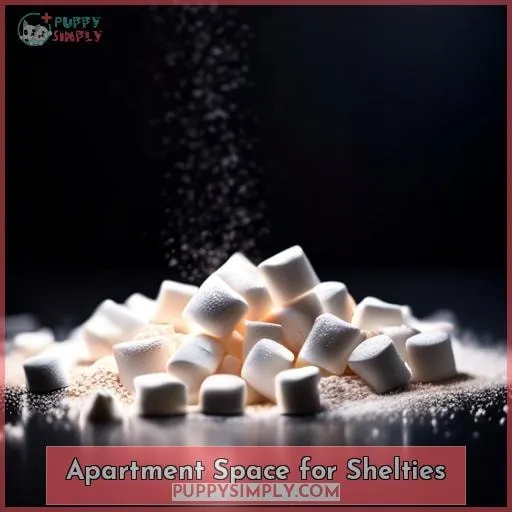This site is supported by our readers. We may earn a commission, at no cost to you, if you purchase through links.
 Have you ever wondered if Shelties make good apartment dogs? You’re not alone.
Have you ever wondered if Shelties make good apartment dogs? You’re not alone.
Shelties are popular companions, but their energetic nature and herding instincts can make apartment living challenging.
In this article, we’ll delve into the unique characteristics of Shelties and explore strategies to help them thrive in apartment environments.
Discover how to:
- Provide adequate exercise
- Minimize barking
- Create a comfortable living space for your furry friend
Table Of Contents
- Key Takeaways
- Sheltie Temperament
- Sheltie Physical Characteristics
- Apartment Space for Shelties
- Exercise Needs in Apartments
- Training for Apartment Living
- Socialization Strategies
- Grooming Requirements
- Mental Stimulation for Shelties
- Health and Veterinary Care
- Frequently Asked Questions (FAQs)
- Is it possible to train a Sheltie to be calm and quiet in an apartment setting, or are they naturally prone to excessive barking and restlessness?
- How often should I take my Sheltie for walks or provide alternative exercise to ensure they are getting enough physical and mental stimulation in an apartment?
- Are there specific grooming techniques or tools that are particularly effective in managing the shedding of a Sheltie in an apartment setting?
- What are some creative ways to provide mental stimulation and enrichment for a Sheltie living in an apartment, especially during times when they cannot go outside?
- Are there any recommended breeds or types of dogs that are generally considered to be better suited for apartment living compared to Shelties?
- Conclusion
Key Takeaways
- Shelties are affectionate, loyal, and intelligent companions that can thrive in apartments with proper training and care.
- Shelties require a designated play area, comfortable bedding, machine-washable bedding, and soundproofing options in apartments.
- Shelties need daily walks, indoor play, interactive toys, and agility courses for physical and mental stimulation.
- Training for apartment living includes minimizing barking, desensitizing Shelties to outside stimuli, potty training, and crate training.
Sheltie Temperament
When considering a Sheltie for apartment living, their temperament is key.
They’re affectionate, loyal, and intelligent, making them easy to train.
However, their herding instincts may require extra attention to prevent unwanted behaviors.
Affectionate and Loyal
With their unwavering loyalty and affectionate nature, Shelties make great apartment companions for those seeking a loving and devoted canine friend.
Their strong bonds with their owners create a sense of comfort and belonging, making them ideal for individuals living in smaller spaces.
Shelties thrive on companionship and shower their owners with affection, providing a sense of safety and unconditional love.
Intelligent and Trainable
Training your intelligent and trainable Sheltie will be a breeze, building a strong bond while teaching them good manners.
Their innate intelligence makes them highly receptive to training, eager to please their owners, and capable of learning a wide range of tricks and commands.
With patience and positive reinforcement, you’ll find that your Sheltie excels in obedience, problem-solving, and even performing entertaining tricks.
Herding Instincts
As a herding breed, you’ll want to take steps to redirect your Sheltie’s instinct to chase and nip at moving objects.
Behavior modification and environmental factors play a role, but genetic predisposition can’t be ignored.
- Engage in herding instinct training to teach your Sheltie to control their impulses and focus on appropriate behavior.
- Provide ample space for your Sheltie to run and play, both indoors and outdoors.
- Socialize your Sheltie with other animals and people to help them learn appropriate social cues.
Sheltie Physical Characteristics
When considering a Sheltie for apartment living, think about their physical characteristics.
You’ll need to brush their double coat weekly to prevent matting and be prepared for shedding.
Shelties are also known for their vocal nature, so training and socialization are key to keeping them quiet in an apartment.
Compact Size
Your Sheltie’s compact size makes it a suitable companion in your apartment.
Its petite stature allows it to navigate small spaces without causing any chaos.
However, you must consider the noise level, pet policy, and reactions of your neighbors.
If excessive shedding and grooming are dealbreakers, you may want to explore alternative breeds better suited for apartment living.
Ultimately, your lifestyle and the apartment environment will determine if a Sheltie is the right match for you.
Double Coat
Shelties’ double coat, consisting of a short, dense undercoat and a long, straight outer layer, requires regular grooming to prevent matting and keep your pet comfortable.
Embrace the beauty of your Sheltie’s coat, showcasing a kaleidoscope of colors and patterns that reflect their unique personality.
Understand that shedding is a natural process, but regular brushing can minimize loose hair, reducing the likelihood of unsightly tumbleweeds forming in your living space.
Be mindful of your Sheltie’s sensitive skin, choosing grooming products that are gentle and free from harsh chemicals.
Prevent matting by brushing your Sheltie’s coat thoroughly and frequently, ensuring their comfort and preventing painful tangles.
Apartment Space for Shelties
Apartment living can be a great option for Shelties.
You’ll need to provide them with a designated play area and comfortable bedding to help them feel at home.
A quiet corner with a soft bed or a crate can give your Sheltie a sense of security and a place to retreat when they need some alone time.
Designated Play Area
You’ll need to create a designated play area in your apartment to give your Sheltie a dedicated space to run, jump, and play.
Consider your apartment layout and choose an area that’s spacious enough for your Sheltie to move around comfortably.
If possible, position the play area near a window or balcony to provide natural light and a view of the outdoors.
Alternatively, take your Sheltie to a nearby dog park for a change of scenery and socialization.
Comfortable Bedding
Create a cozy corner for your Sheltie’s bed in a quiet area of your apartment, away from high-traffic zones.
Opt for a soft, elevated dog bed with a warm blanket to ensure maximum comfort.
Consider placing the bed near a window so your Sheltie can enjoy the view and natural light.
Ensure the bedding is machine-washable for easy cleaning and maintenance.
Exercise Needs in Apartments
Shelties require ample exercise, even in apartments.
Engage your Sheltie in daily walks, indoor fetch, and interactive toys to meet their physical and mental needs.
Consistency in exercise helps keep your Sheltie happy and healthy in an apartment setting.
Daily Walks
For apartment-dwelling Shelties, daily walks around the neighborhood are essential for their physical and mental well-being.
Embark on leisurely strolls, brisk walks, or invigorating hikes to stimulate their active minds and bodies.
Vary your walking routes to introduce new sights, sounds, and smells, keeping their walks interesting and engaging.
Incorporate leash training to ensure safe and controlled walks, and consider enrolling your Sheltie in agility classes or canine sports to further channel their boundless energy.
When unable to venture outdoors, engage your Sheltie in indoor games like fetch or hide-and-seek to fulfill their exercise needs.
Indoor Play
To keep your Sheltie active and engaged indoors, dedicate a portion of your apartment as a designated play area.
Fill it with interactive toys that encourage mental stimulation and quiet playtime.
Puzzle feeders and treat-dispensing toys are great options for keeping your Sheltie occupied.
Rotate toys regularly to maintain their interest and prevent boredom.
Consider setting up an indoor agility course using everyday items like chairs and boxes to provide physical and mental challenges.
Training for Apartment Living
Training is key for apartment living.
You’ll want to focus on minimizing barking, especially if your neighbors are close by.
You’ll also want to make sure your Sheltie is potty trained so they don’t have accidents inside.
Minimizing Barking
Harness your Sheltie’s intelligence by implementing positive reinforcement training techniques to reduce barking.
Start by identifying triggers and rewarding quiet behavior.
Window Training:
Desensitize your Sheltie to outside stimuli by gradually exposing them to the view from a window while rewarding calmness.
Soundproofing Options:
Consider soundproofing your apartment to minimize noise disturbances and create a quieter environment for your Sheltie.
Acoustic Treatments:
Utilize acoustic treatments like rugs, curtains, and foam panels to absorb sound and reduce echo within your apartment.
Potty Training
Start potty training your Sheltie early on.
Establish a consistent routine for eliminating outdoors.
Utilize positive reinforcement techniques, such as treats and praise, to reward your pup for successful elimination in the designated area.
Consider crate training to help control accidents and provide a safe, private space for your Sheltie when you’re away.
If accidents do occur, clean them up thoroughly to prevent your Sheltie from associating the area with elimination.
Patience and consistency are key to successful potty training, so stay committed and your Sheltie will soon master the art of apartment-friendly potty etiquette.
Socialization Strategies
As you introduce your Sheltie to apartment living, don’t neglect socialization.
Make an effort to:
- Meet and greet neighbors who have dogs.
- Schedule outings to dog parks where your pup can interact with other canines.
These encounters help your Sheltie adapt to various social situations and prevent boredom and loneliness.
Meeting Neighbors
Integrating your Sheltie into the community means introducing them to friendly neighbors for positive socialization.
Begin by exchanging pleasantries and introducing your furry companion.
Observe their body language; a relaxed stance and wagging tail indicate comfort.
If both dogs seem receptive, allow them to sniff and interact briefly.
Respect neighbors’ boundaries; ask before petting their pets, and keep your dog on a leash in shared spaces.
Dog Park Visits
Visiting dog parks provides a social environment for your Sheltie, allowing them to interact, play, and make friends.
Prioritize safety by selecting parks with separate areas for different dog sizes and ensuring your Sheltie is up-to-date on vaccinations.
Observe group dynamics, respecting other dogs’ boundaries and intervening if necessary.
Follow etiquette guidelines, such as cleaning up after your Sheltie and respecting other owners’ space.
Manage time, balancing socialization with exercise and rest.
Encourage participation by bringing interactive toys or treats, making the experience enjoyable for your Sheltie.
Grooming Requirements
Shelties have beautiful coats that require regular brushing to prevent matting and tangles.
You’ll also need to trim your Sheltie’s nails every two weeks to keep them short and healthy.
Coat Maintenance
Now that your Sheltie has settled into your apartment and made some friends, it’s time to discuss coat maintenance.
Shelties aren’t hypoallergenic, so daily brushing is crucial to control shedding and prevent coat matting.
Invest in quality grooming tools, like a slicker brush and a metal comb, to keep your Sheltie’s coat healthy and shiny.
Regular brushing also helps build a strong bond with your furry companion.
Nail Trimming
Likewise, you’ll need to trim your Sheltie’s nails regularly to prevent discomfort and maintain nail health.
Establish a nail trimming routine, using appropriate nail clippers, to keep nails short and smooth.
Regular nail care not only ensures your Sheltie’s comfort while walking or playing but also prevents potential injuries to you and your family.
Mental Stimulation for Shelties
To stimulate your Sheltie mentally, offer interactive toys and games that challenge their problem-solving skills.
Consider your Sheltie in training classes to keep their mind active and engaged.
This will help prevent boredom and destructive behaviors.
Interactive Toys
To keep your Sheltie mentally stimulated in an apartment, provide interactive toys that challenge their intelligence and encourage problem-solving.
- Treat puzzle toys challenge their problem-solving skills and reward them with treats.
- Food dispensing toys keep them engaged and distracted, slowing down their eating pace.
Calming chews provide a soothing and satisfying activity, reducing stress and anxiety.
Interactive feeders turn mealtime into a fun and engaging experience, stimulating their minds.
Training Challenges
Alongside interactive toys, training challenges can further engage your Sheltie’s mind, keeping them mentally stimulated and entertained.
With their innate intelligence, Shelties thrive on learning new tricks and commands.
Incorporate training sessions into your daily routine, challenging them with obedience exercises, agility courses, or puzzle toys.
This not only strengthens your bond but also provides mental stimulation, reducing boredom and destructive behaviors.
Health and Veterinary Care
Partner with your vet to safeguard your Sheltie’s well-being.
Together, you can implement a preventive healthcare plan that includes:
- Regular checkups
- Vaccinations
- Treatments to address any health concerns that may arise
This proactive approach will help ensure your Sheltie’s continued health and happiness.
Regular Check-ups
You should partner with your veterinarian for regular check-ups and preventative care to ensure your Sheltie’s well-being.
Follow veterinary recommendations for:
- Vaccination schedules
- Dental care
- Flea and tick prevention
- Emergency preparedness
These measures safeguard your Sheltie’s health, catch potential issues early, and promote a longer, happier life together.
Preventative Measures
In tandem with regular check-ups, preventative measures like vaccinations and deworming help maintain your Sheltie’s health and prevent future issues.
- Vaccinate on Schedule: Follow your veterinarian’s recommended vaccination schedule to protect your Sheltie from contagious diseases.
- Prevent Parasites: Use flea and tick prevention products regularly to keep your pet free from these pests.
- Maintain Dental Health: Establish a dental care routine to prevent dental disease and keep your Sheltie’s mouth healthy.
- Monitor for Signs of Illness: Regularly check your Sheltie for any signs of illness, such as changes in appetite, behavior, or energy levels.
Frequently Asked Questions (FAQs)
Is it possible to train a Sheltie to be calm and quiet in an apartment setting, or are they naturally prone to excessive barking and restlessness?
With consistent training and positive reinforcement, you can teach your Sheltie to control its vocal behavior.
You can also teach your Sheltie to remain calm in an apartment setting.
This will promote a harmonious living environment.
How often should I take my Sheltie for walks or provide alternative exercise to ensure they are getting enough physical and mental stimulation in an apartment?
Picture daily jaunts through the park,
frisbee dances in open fields,
and indoor games of chase.
Aim for at least two 30-minute walks,
or an hour of active play,
to keep your Sheltie happy and healthy in your apartment.
Are there specific grooming techniques or tools that are particularly effective in managing the shedding of a Sheltie in an apartment setting?
Effective grooming techniques and tools can help manage shedding.
Regular brushing with a slicker brush and occasional deshedding tools can reduce loose hair in your apartment and keep your Sheltie’s coat healthy.
What are some creative ways to provide mental stimulation and enrichment for a Sheltie living in an apartment, especially during times when they cannot go outside?
Engage your Sheltie’s sharp mind with:
- Indoor agility courses
- Puzzle toys
- Interactive feeders
These activities stimulate their intellect and provide mental enrichment, even when stuck inside.
Are there any recommended breeds or types of dogs that are generally considered to be better suited for apartment living compared to Shelties?
Consider breeds known for their adaptability, calmness, and low maintenance needs.
Research extensively to find a companion that aligns with your lifestyle and apartment living constraints.
Conclusion
Did you know that Shelties rank among the top 10 most intelligent dog breeds?
Their exceptional intelligence makes them highly receptive to training, which is crucial for apartment living.
With patience, consistency, and the right strategies, you can create a harmonious and enjoyable home for both you and your beloved Sheltie in an apartment setting.














